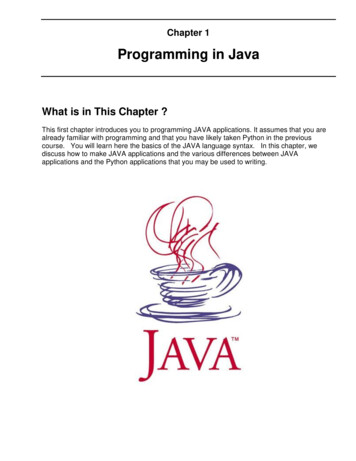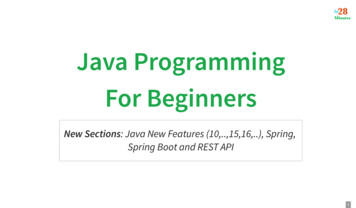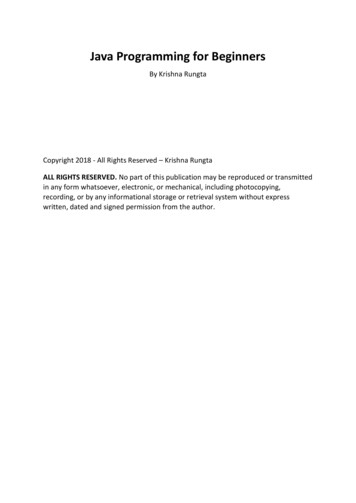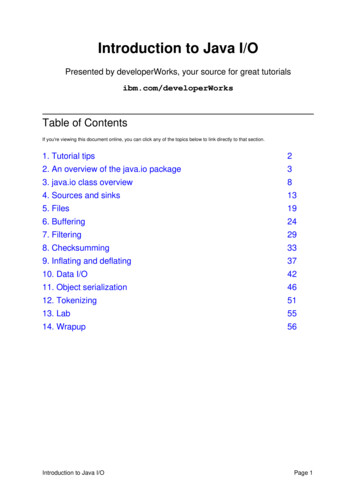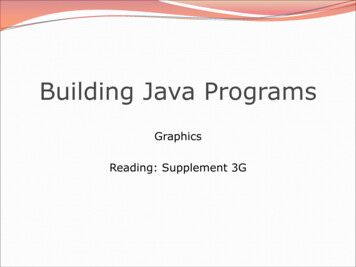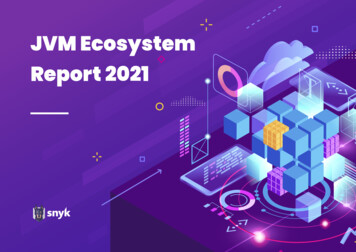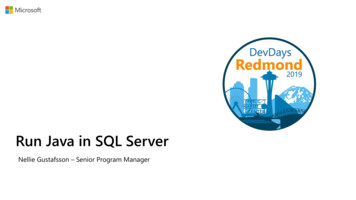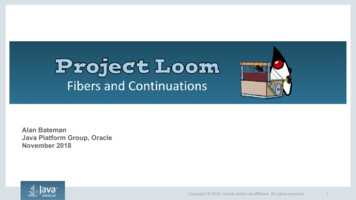
Transcription
Alan BatemanJava Platform Group, OracleNovember 2018Copyright 2018, Oracle and/or its affiliates. All rights reserved.!1
Project Loom Continuations Fibers Tail-callsCopyright 2018, Oracle and/or its affiliates. All rights reserved.!2
Why FibersToday, developers choose betweenConnectionsAppsimple (blocking / synchronous),but less scalable code (with threads)andConnectionsAppcomplex, non-legacy-interoperable,but scalable code (asynchronous)Copyright 2018, Oracle and/or its affiliates. All rights reserved.!3
Why FibersWith fibers, devs have both: simple, familiar, maintainable,interoperable code, that is also scalableConnectionsAppFibers make even existing server applications consume fewermachines (by increasing utilization), significantly reducing costsCopyright 2018, Oracle and/or its affiliates. All rights reserved.!4
ContinuationsCopyright 2018, Oracle and/or its affiliates. All rights reserved.!5
A continuation (precisely: delimited continuation) is aprogram object representing a computation that may besuspended and resumed (also, possibly, cloned or evenserialized).Copyright 2018, Oracle and/or its affiliates. All rights reserved.!6
Prototype Continuation APIpackage java.lang;public class Continuation implements Runnable {public Continuation(ContinuationScope scope, Runnable target)public final void run()public static void yield(ContinuationScope scope)public boolean isDone():}Copyright 2018, Oracle and/or its affiliates. All rights reserved.!7
FibersCopyright 2018, Oracle and/or its affiliates. All rights reserved.!8
A Fiber light weight or user mode thread, scheduled by theJava virtual machine, not the operating systemFibers are low footprint and have negilgible task-switchingoverhead. You can have millions of them!Copyright 2018, Oracle and/or its affiliates. All rights reserved.!9
Why fibers? The runtime is well positioned to manage and scheduleapplication threads, esp. if they interleave computationand I/O and interact very often (exactly how server threadsbehave) Make concurrency simple againCopyright 2018, Oracle and/or its affiliates. All rights reserved.!10
fiber continuation schedulerCopyright 2018, Oracle and/or its affiliates. All rights reserved.!11
fiber continuation scheduler A fiber wraps a task in a continuation The continuation yields when the task needs to block The continuation is continued when the task is ready to continueScheduler executes tasks on a pool of carrier threads java.util.concurrent.Executor in the current prototype Default/built-in scheduler is a ForkJoinPoolCopyright 2018, Oracle and/or its affiliates. All rights reserved.!12
Fiber prototype Focus to date has been on the control flow and concepts, not theAPI Minimal java.lang.Fiber in current prototype that supportsscheduling, park/unpark, and waiting for a fiber to terminate java.util.concurrent APIs can park/unpark fibers Socket and pipe APIs park fiber rather than block threads in syscallsCopyright 2018, Oracle and/or its affiliates. All rights reserved.!13
How much existing code can fibers run? A big question, lots of trade-offs Do we completely re-imagine threads? Can we run all existing code in the context of a fiber? Likely to wrestle with these questions for a long time Current prototype can run existing code but with some limitationsCopyright 2018, Oracle and/or its affiliates. All rights reserved.!14
Example using existing code/libraries Example uses Jetty and JerseyCopyright 2018, Oracle and/or its affiliates. All rights reserved.!15
Example with existing code/libraries Assume servlet or REST service that spends a long time waitingassume this takes 100msCopyright 2018, Oracle and/or its affiliates. All rights reserved.!16
Default configuration (maxThreads 200), load 5000 HTTP request/sCopyright 2018, Oracle and/or its affiliates. All rights reserved.!17
maxThreads 400, load 5000 HTTP request/sCopyright 2018, Oracle and/or its affiliates. All rights reserved.!18
fiber per request, load 5000 HTTP request/sCopyright 2018, Oracle and/or its affiliates. All rights reserved.!19
Current limitations Can’t yield with native frames on continuation stack Can’t yield while holding a monitor In both cases, parking pins the carrier thread monitorenter/Object.wait may park carrier threadCopyright 2018, Oracle and/or its affiliates. All rights reserved.!20
Back to the big questions Will fibers be able to run all existing code? Should we completely re-imagine threads?Copyright 2018, Oracle and/or its affiliates. All rights reserved.!21
Thread.currentThread() and Thread API A lot of existing code uses the Thread API andThread.currentThread() (maybe indirectly) For now, current prototype can run in a mode thatemulates Thread.currentThread() and most of theThread API. That allows fibers to run existing code. Project Loom is the opportunity to re-imagine threadsCopyright 2018, Oracle and/or its affiliates. All rights reserved.!22
What is wrong with java.lang.Thread ThreadGroup Context ClassLoader Inheritance: TCCL, ACC, InheritedThreadLocals suspend/resume, deprecated for 20 years Thread interrupt problematic with threads pools Thread locals Copyright 2018, Oracle and/or its affiliates. All rights reserved.!23
Thread locals e.g. container managed cache of connection or credentials context Long-standing source of memory leaks in thread pools Often used because because isn’t anything better Sometimes used to make context available to callees Sometimes used as approximation to “processor locals”Copyright 2018, Oracle and/or its affiliates. All rights reserved.!24
Locals (exploring) Frame/scope locals Locals that are accessible to calleese.g. Clojure dynamic binding, special variables in Lisp Semantics TDB Maybe tied with Structured ConcurrencyProcessor locals Locals keyed on cpu ID rather than Thread Potential users are Striped64/LongAddr to avoid needing fields in ThreadCopyright 2018, Oracle and/or its affiliates. All rights reserved.!25
Structured Concurrency (exploring) Core idea“every time that control splits into multiple concurrent paths, we want to make sure that they join up again”. Background reading and motivations: Nathaniel J Smith blogs: Notes on structured concurrency, or: Go statement considered harmful Timeouts and cancellation for humansAlso Martin Sustrik blogs on state machines and structured concurrency in high-level languagesImplemented as Nurseries in Python Trio libraryCopyright 2018, Oracle and/or its affiliates. All rights reserved.!26
Structured Concurrency Early prototype, but not in loom/loom yetInstant deadline ne(deadline).run(() - {Fiber ? fiber1 Fiber ? fiber2 });fiber1 and fiber2 guaranteed to have terminatedCopyright 2018, Oracle and/or its affiliates. All rights reserved.!27
Communication between fibers Current prototype executes tasks as Runnable orCallables j.u.concurrent just works so can share objects or shareby communicating Not an explicit goal at this time to introduce Channelsor other concurrency APIs but new APIs may emergeCopyright 2018, Oracle and/or its affiliates. All rights reserved.!28
Current status Initial prototype with Continuation and Fiber support Current focused on Performance Fiber API Debugger supportSeveral other topics under explorationCopyright 2018, Oracle and/or its affiliates. All rights reserved.!29
APIs that potentially park in current prototype Thread sleep, join java.util.concurrent and LockSupport.park Networking socket read/write/connect/accept Pipe read/writeCopyright 2018, Oracle and/or its affiliates. All rights reserved.!30
Footprint Thread Typically 1MB reserved for stack 16KB of kernel data structures 2300 bytes per started Thread, includes VM meta dataFiber Continuation stack: hundreds of bytes to KBs 200-240 bytes per fiber in current prototypeCopyright 2018, Oracle and/or its affiliates. All rights reserved.!31
Debugging and serviceability Basic support in JVM TI to track fiber scheduling, mountand unmount Hope to have some basic debugger support soon No investigation yet on JMX/java.lang.management andother tool APIsCopyright 2018, Oracle and/or its affiliates. All rights reserved.!32
Other topics to explore Tail calls Forced preemption Serialization and cloningCopyright 2018, Oracle and/or its affiliates. All rights reserved.!33
More information Project Loom page: http://openjdk.java.net/projects/loom/ Mailing list: loom-dev@openjdk.java.net Repo: http://hg.openjdk.java/net/loom/loom (fibers branch)Copyright 2018, Oracle and/or its affiliates. All rights reserved.!34
Safe Harbor StatementThe following is intended to outline our general product direction. It isintended for information purposes only, and may not be incorporated intoany contract. It is not a commitment to deliver any material, code, orfunctionality, and should not be relied upon in making purchasingdecisions. The development, release, and timing of any features orfunctionality described for Oracle’s products remains at the sole discretionof Oracle.Copyright 2018, Oracle and/or its affiliates. All rights reserved.!35
Minimal java.lang.Fiber in current prototype that supports scheduling, park/unpark, and waiting for a fiber to terminate java.util.concurrent APIs can park/unpark fibers Socket and pipe APIs park fiber rather than block threads in syscalls Fiber prototype


